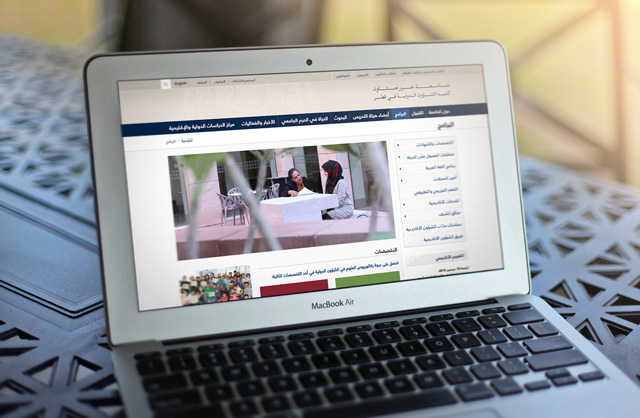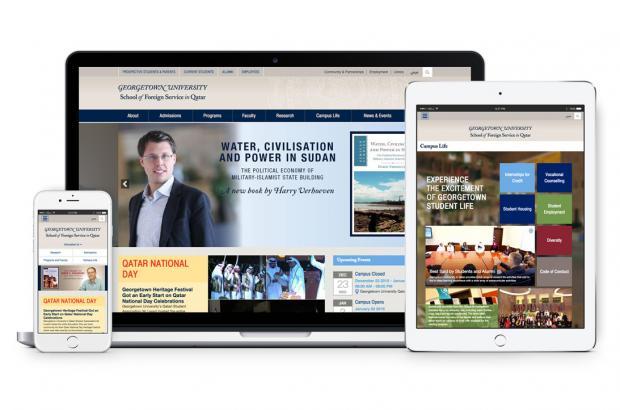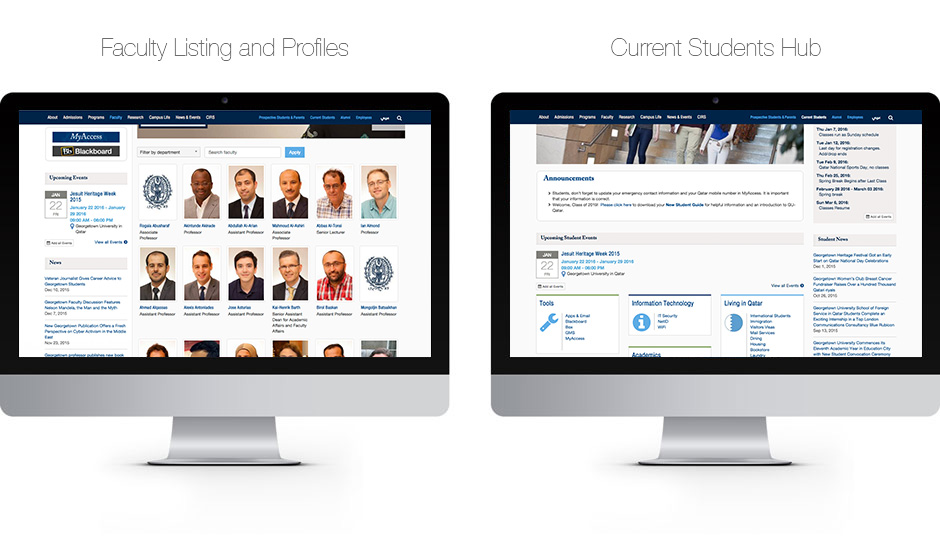 Support for Drupal 7 is ending on 5 January 2025—it’s time to migrate to Drupal 10! Learn about the many benefits of Drupal 10 and find migration tools in our resource center.
Support for Drupal 7 is ending on 5 January 2025—it’s time to migrate to Drupal 10! Learn about the many benefits of Drupal 10 and find migration tools in our resource center.Georgetown University School of Foreign Service in Qatar (GU-Q) hosts a dual language, Arabic and English website with 1800+ indexed pages and 800+ publications on the website. Their previous Keybridge Systems Cold Fusion based website suffered from declining performance, lagging speed and an obsolete architecture, on an outdated back-end that was difficult to manage and update. This provided for an ineffective and poor quality user experience and it created difficulties for site editors and administrators.
After a full website audit, it was determined that a complete redevelopment and restructuring of the website was appropriate for the future needs of the campus. GU-Q partnered with Vardot for the complete rebuild of their website from scratch, starting with a remodel of the front-end design in accordance with Georgetown University brand guidelines, a restructuring of the information architecture and a complete back-end rebuild on Drupal CMS.


Drupal was chosen because GU-Q needed a flexible and scalable content management system that could handle a large number of pages (2,000+), content types, and permission levels, while providing flexibility for users and editors alike.
Additional factors included the large number of high-quality community contributed modules and integrations with third-party software systems.
The mission was to build an SEO-optimized, high-performance university portal that could handle a large number of pages and a high volume of traffic. In addition, the site needed to be mobile enhanced with a responsive layout, integrated with an external authentication system, provide advanced search capabilities to help structure and organize over 800 publications within the website, and finally to have a flexible layout manager to help manage the website easily and place events and news content on different pages of the website.
Vardot built a university portal that was user friendly and accessible for all web audiences, including current students, faculty, prospective students, alumni, parents, employees and researchers. After conducting an extensive audit of the old website, Vardot traveled to the Qatar campus to meet and interview various members of the GU-Q community including teaching faculty, administrative staff, students and other website users. While in Qatar, workshops were conducted during the week to better understand the needs of each audience segment. Afterwards an information architecture strategy was developed for the design of the new website, which enabled Vardot to provide a better experience for the different user segments of the website. Students and parents were provided a far quicker way to find relevant information on the website through dedicated pages for their needs, and an extensive mega-menu that was created to help users navigate through a broad range of content quickly.
An employee microsite was created for the internal audience which can be accessed using a Single Sign-On ID integrated with an external identity solution through the Shibboleth Drupal Login Handler which allows users to securely sign-in with their GU-Q ID, from any device.
The Biblio module was integrated for managing publications on the website, and GU-Q social media and YouTube channels were integrated into the website to pull the latest videos and social posts to the front page and other sections. News and calendar events were aggregated from the website and embedded into the Georgetown Mobile app. Both public events and academic calendars on the website were equipped with the ability to be added and synchronized with the user’s personal calendar through iCal feeds.
A flexible drag-and-drop layout manager was also built into this project, making the process of updating and adding content a simple task that can be completed by people with minimal technical background in minutes. In addition to that, more than 20 pre-loaded page layouts are also available and can be applied to pages and for all content types. The site is also optimized for all screen sizes, all modern-browsers, and all mobile operating systems.

Site wide search functions make all content easily discoverable. In the publication section you can look up any paper by name, type, conference, year, or tag. Similarly, expert profiles in the website can be searched by language, expertise, country, and name. News can be filtered by category or easily embedded on the homepage with a single click.
Performance for the site was tremendously improved on Drupal 7. Varnish was integrated for better caching, and the university home page with a lot of images and content loads extremely fast. SEO optimizations helped with the discoverability of the site and the user experience for viewers: both the time-on-site and page view count have increased significantly with the new site. All of this helped rank the new GU-Q website higher, helping the campus in Qatar attract new students and employee talents while better serving their existing community of students, faculty and the general public.
Users may visit the completed sites at:
English: http://qatar.sfs.georgetown.edu/
Arabic: http://qatar.sfs.georgetown.edu/ar
Center Microsite English: http://cirs.georgetown.edu/
Center Microsite Arabic: http://cirs.georgetown.edu/ar
Technical specifications
The main distribution used to enhance the usability of the administration experience is Varbase: Drupal Bundled with Necessities. Which also comes prepackaged with a lot of enhancements and best practices modules and features.
A few highlights are:
Navigation & Paths Management:
- Menu Block: To dynamically create menu blocks from menu hierarchy.
- Menu Position: The site consisted of many content types, and each was assigned in a specific section. This module managed the breadcrumbs trail for each content type.
- Path Breadcrumbs: Building breadcrumbs based on paths.
Mobile & Responsive Tools:
- Breakpoints: To build a responsive front end.
- Responsive Theme Preview: To allow editors to preview how the site looks instantly from the front-end for a number of preset device screen sizes.
- Responsive Menus: To generate mobile-friendly menu, given the large amount of menu links and hierarchy.
Usable Management & Administration:
- Entityqueue: To allows editors to easily sort content in displayed from views.
- Pathologic, Image Resize Filter, Linkit: A trio of input filters were used to correct paths in links and images in the content if the URL of the site changes or the content is moved to a different server.
- Drag & Drop Upload: Provides a drag & drop upload element and widgets for a file and an image field.
- Workbench: Improves editorial workflow by simplifying the interface for users who only have to work with content; allows user permission control based on organization-structure not website structure.
- Fieldable Panels Panes: Generates an entity that may be used in panel panes to create field-able entity panes using the Panels UI or a separate administrative UI.
Layout Management:
- Panelizer: Allows administrator to attach panels to any node in the system using multiple entity types, and choose which content and layouts are allowed.
- Display Suite: Drag and drop interface that smoothly controls how your content is displayed; for example, arranging your nodes, views, comments, user data etc.
Multisite:
- Domain Access: A suite of tools for running a virtual sites. Was used to implement CIRS website, yet provide one administration backend for both websites.
Multilingual:
- Internationalization and Entity Translation: To provide multilingual website.
Other key modules:
- simpleSAMLphp Authentication: GU-Q uses Shibboleth for Single Sign On (SSO). This module was used to provide SSO capability to site users.
- Features: To provide standard best-practice management of configuration and site's features.
- Apache Solr Search: Search portal that allows for the organized retrieval of structured and unstructured data within an organization.
- Feeds: Allows users to import or aggregate data as nodes, users, taxonomy terms or simple database records.
Performance:
- Memcache: A memory caching system that speeds up dynamic database-driven websites by caching data and objects in RAM.
- HTTP Parallel Request & Threading Library: An API that other modules/code can use and sends out http requests in a parallel blocking or non-blocking way.
Several patches and modules have been contributed while building the GU-Q website.
Full Projects:
- Email Conceal Filter: Automatically converts email addresses to a link to hide the email address, and populates a form to contact the intended email.
- Workbench Access Content Type: Extendible editorial access for the Workbench suite by content types; for example, it will add a new tab "Content Types" at the configuration page of Workbench Access, to provide permission by Section by Content Type.
Patches:
- #2398291: Right to Left Support
- #1464950: Support for multiple "Field collection" and "Multifield" fields
- #2327403: JSON API Pagination support
- #2400421: Filter language list for editors.
- #2379105: Domain Access is altering the Action for Forms When we have Secure Pages Module
- #2429281: Language access is not working for nodes with a restricted language of the node it's only for the language of the user
- #2545236: Entity reference title show always as the default language
- #1908148: Update tag list for locale_string_is_safe() like filter_xss_admin()
- #545722: Weighted listing for Publication Types
- #2120849: Decrease Panels IPE CSS & JS specificity to allow "button" elements
- #2418091: "Search Result" and "Search Index" is not created on module enable
- #2299463: "open, animating" classes added to entire site menus.
- #2420641: Videos pulled from Youtube pulls the small thumbnail
- #2390715: Using save_user on user login cause problem with other modules
GU-Q Team Members:
- Moamer Qazafi, Chief Communications Officer
- Waleed Khan, Associate Director for Marketing
- Michael McHarg, Assistant Director for Risk and Strategy.
- Bernard Assaf, Information Security & Application Manager
- Diana El Bezri, Web Content Manager
- Nick Mathew, Web Developer